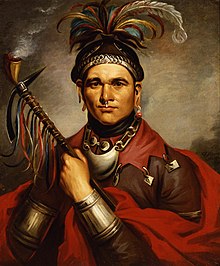Cornplanter
| Cornplanter | |
|---|---|
| Gaiänt'wakê, Kaintwakon | |

Chief Cornplanter, portrait by Frederick Bartoli, 1796
|
|
| Seneca leader | |
| Succeeded by | Edward Cornplanter |
| Personal details | |
| Born | Between 1732 and 1746 Canawaugus (now part of Caledonia, New York) |
| Died | 1836 Cornplanter Tract, Pennsylvania |
| Resting place | Corydon, Pennsylvania |
| Relations | Brother, Half-Town; half-brother, Handsome Lake. Uncle, Guyasutha. Nephew, Governor Blacksnake. |
| Children | Henry Abeele, Edward Cornplanter |
| Parents | Aliquipiso/Gahonnoneh (Seneca), Johannes Abeel (Dutch) |
| Known for | War chief during the French and Indian War. Fought with British during American Revolutionary War. Known for his diplomacy. Opposed liquor; worked with Quakers to bring farming to the Seneca. His home, the Cornplanter Tract, was flooded by Kinzua Dam. |
| Nickname(s) | John Abeel, John O'Bail |
John Abeel III (born between 1732 and 1746–February 18, 1836), known as Gaiänt'wakê (Gyantwachia - ″the planter″) or Kaiiontwa'kon (Kaintwakon - "By What One Plants") in the Seneca language and thus generally known as Cornplanter was a Seneca war chief and diplomat. As a chief warrior, Cornplanter fought in the French and Indian War and the American Revolutionary War. In both wars, the Seneca and three other Iroquois nations were allied with the British. After the war Cornplanter led negotiations with the United States and was a signatory of the Treaty of Fort Stanwix (1784). He helped gain Iroquois neutrality during the Northwest Indian War.
In the postwar years, he worked to learn more about European-American ways and invited Quakers to establish schools in Seneca territory. Disillusioned by his people's poor reaction to European-American society, he had the schools closed and followed his half-brother Handsome Lake's movement returning to traditional Seneca way. The United States government granted him about 1500 acres of former Seneca territory in Pennsylvania in 1796 for "him and his heirs forever", which became known as the Cornplanter Tract. It was flooded in 1965 by the Kinzua Dam, and most of the remaining residents were relocated to the Allegany Reservation of the federally recognized Seneca Nation of New York.
Cornplanter was born between 1732 and 1746 at Canawaugus (now in the Town of Caledonia) on the Genesee River in present-day New York State. He was the son of a Seneca woman, Gah-hon-no-neh (She Who Goes to the River), and a Dutch man, Johannes "John" Abeel II.
...
Wikipedia
